This was published 5 years ago
Nagasaki Atomic Bomb Museum: Japan's atomic bomb museum that doesn't shy away from the truth
By Louise Southerden
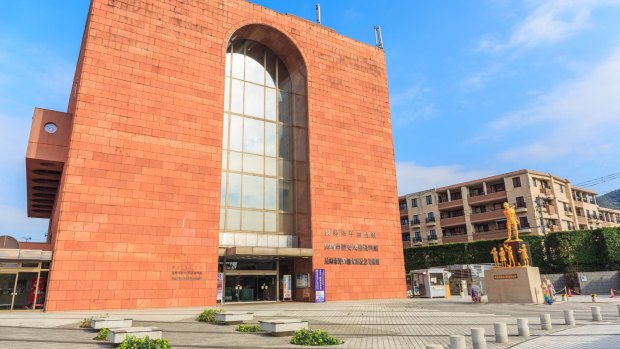
The Nagasaki Atomic Bomb Museum.Credit: Shutterstock
It's 11am on August 9, 1945, a typical Thursday morning for the citizens of one of Japan's most multicultural cities. The streetcars are running, the church bells are tolling, the port that was Japan's only gateway to the outside world is buzzing.
Two minutes later 120,000 lives change forever. At least 40,000 of them end instantly, a third of the city is levelled and tens of thousands of people within a few kilometres of the blast will suffer the effects of radiation for decades to come.
This is how the experience of visiting Nagasaki Atomic Bomb Museum begins – by showing you what Nagasaki was like before the bomb then in its immediate aftermath. Walking down the white-walled spiral ramp from ground level to the three underground exhibition halls prepares you, sort of, by asking that you please walk quietly to "calm your mind".
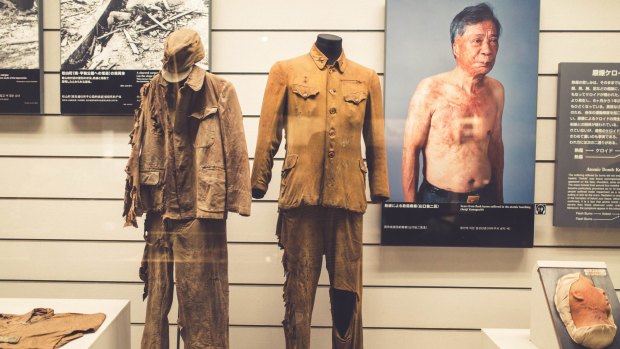
Exhibitions on display at The Nagasaki Atomic Bomb Museum.Credit: Shutterstock
As a "dark tourism" site, this museum was never going to be less than sobering, but I'm surprised at how hopeful it is, too.
Its saving grace is that it's not just about what happened three days after the first atomic bomb dropped on Hiroshima. After zooming in on the initial devastation, with displays of scorched clothes and melted glass bottles and black-and-white photos, we pull out to view the bombing in a broader context through the lens of the world affairs leading to it – from the 1931 Manchurian Incident (an explosion staged by Japan ahead of its invasion of north-eastern China) to the bombing of Pearl Harbour and the agreement made by Winston Churchill and Franklin D. Roosevelt in 1944 that "the bomb" should be used against Japan to end the war.
On the Saturday afternoon I'm at the museum, it is busy but absolutely silent. Subdued lighting adds to the sombre mood. Audio headsets allow everyone to wander at will, and to just stand and stare when necessary. One of the most moving exhibits includes audio accounts of survivors, including a few children and five Australian prisoners of war living in a camp in Nagasaki at the time.
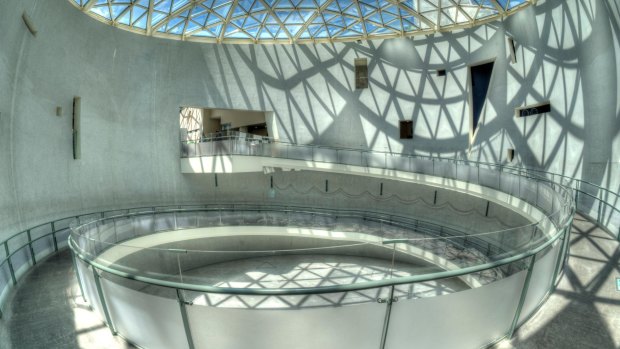
The foyer entrance inside the Nagasaki A-Bomb Museum.Credit: Alamy
The facts are grimly fascinating: the bomb exploded 500 metres above ground; within seconds the blast had travelled 11 kilometres from its hypocentre, where temperatures reached 4000 degrees , and it created hurricane-force winds that then reversed, sucking everything dislodged back towards ground zero. And who knew Fat Man – the obscenely jokey name for the bomb, which was only as long as a malibu surfboard but weighed as much as four small cars – was bright yellow?
There's a big section on the history of nuclear weapons, from the discovery of nuclear fission by German scientists in 1938 to the nuclear test ban treaty signed by 183 nations in 1996. It's reassuring to know that the southern hemisphere is mostly covered by nuclear-free zones. And alarming to learn that since Nagasaki, eight nations have conducted more than 2000 nuclear tests at dozens of sites around the world, including Maralinga and Emu Field in South Australia and the Montebello Islands in Western Australia in the 1950s.
This segues into the rise of the global peace movement and how the cities of Nagasaki and Hiroshima have played their roles as advocates for peace.
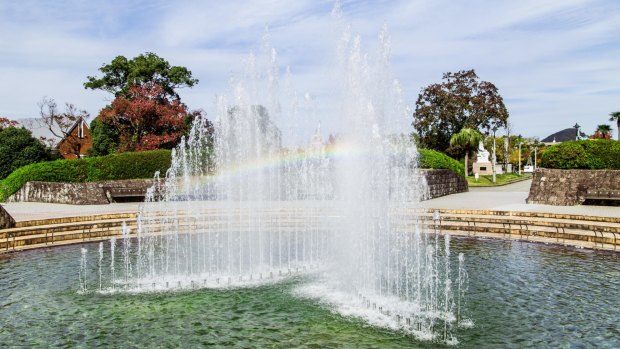
Nagasaki Peace Park fountain. Credit: Alamy
Back in the museum lobby at the end of my visit, I pass racks and racks of hand-made paper cranes in rainbow colours, a recent "gift of understanding and friendship" from the Los Alamos History Museum in New Mexico, where the world's first nuclear weapon was detonated on July 16, 1945. As I hand back my audio set, an attendant holds out a basket of origami cranes and asks me to pick one as a gift.
Outside, to clear my head, I walk to the nearby Fountain of Peace, where water sprays in the shape of a dove's wings, and the Peace Monument, a bronze statue erected in 1955 that depicts a muscular man who could be Michelangelo's David's brother, except he's not ready for battle; one leg is folded under him in meditation and his demeanour is one of serenity.
Crossing a small park with a shiny black shard reaching for the blue sky, I suddenly feel overwhelmed by all I'd seen, heard and learned at the museum. Then I look up and feel calmed by the simple solemnity, the gravity, of this stone marking the bomb's hypocentre. Right here, I think. Seventy-four years ago. And Nagasaki's message of peace is as urgent as ever.
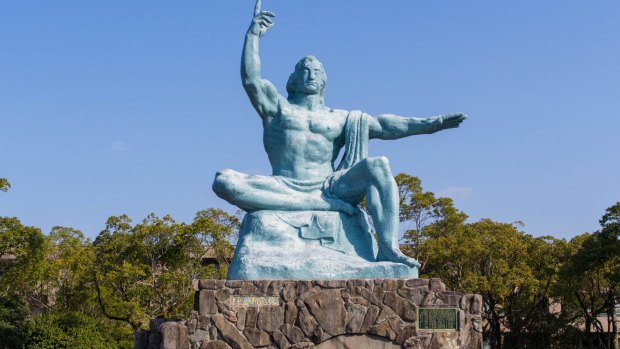
Peace Statue in Nagasaki Peace Park.Credit: Shutterstock
TRIP NOTES
Louise Southerden travelled with assistance from Kyushu Tourism and Walk Japan.
MORE
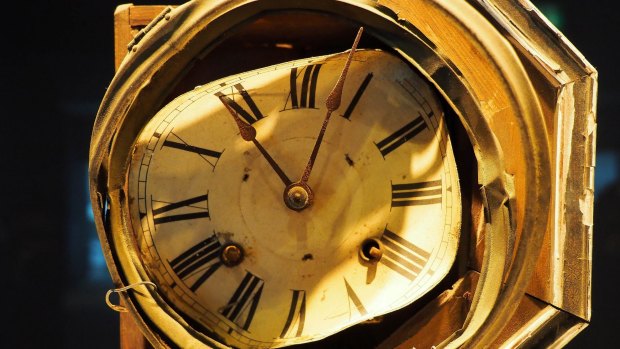
The clock display the exact time that the Atomic Bomb hit Nagasaki prefecture display at Nagasaki Atomic Bomb Museum.Credit: Shutterstock
FLY
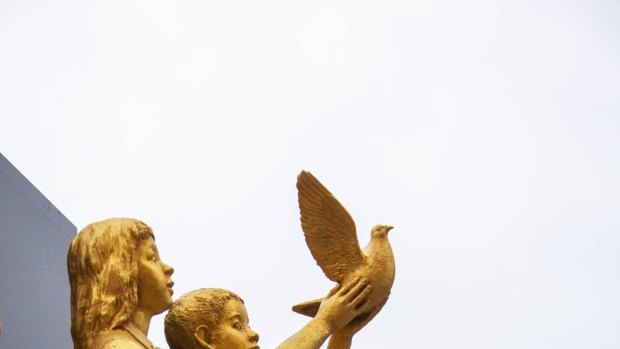
19 aug. 2016 - Nagasaki National Peace Memorial Hall for the Atomic Bomb Victims SunFeb3Japan - Nagasaki Atomic Bomb Museum - Louise Southerden Credit: ShutterstockCredit: SHUTTERSTOCK
Cathay Pacific flies daily to Fukuoka via Hong Kong from Sydney, Melbourne, Brisbane, Adelaide and Perth. See cathaypacific.com
VISIT
Nagasaki Atomic Bomb Museum is open every day except December 29-31. It costs ¥200 for adults, ¥100 for children. See nagasakipeace.jp
Sign up for the Traveller Deals newsletter
Get exclusive travel deals delivered straight to your inbox. Sign up now.